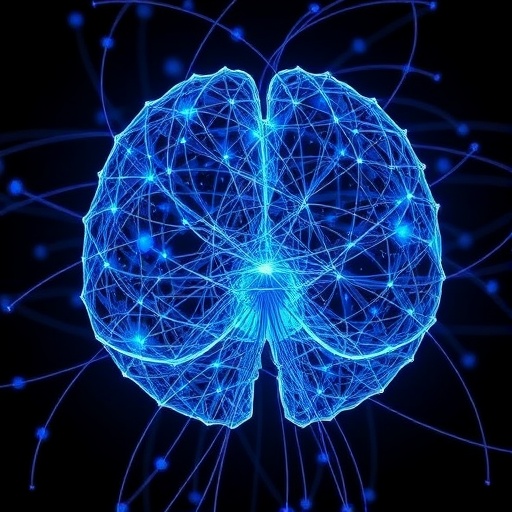Recent advances in neuroscience have illuminated a remarkable disynaptic circuit that links higher-order brain regions with the hypothalamic neuroendocrine system, providing new insights into how stress signals are transduced into hormonal responses. Utilizing state-of-the-art viral tracing techniques combined with optogenetic modulation, researchers have traced and functionally validated pathways from the ventral subiculum (SUBv) and basolateral amygdala anterior (BLAa) to a distinct population of neurons within the dorsal peduncular cortex (DPd), which in turn project to corticotropin-releasing hormone (CRH) neurons in the paraventricular hypothalamus (PVH). This circuitry offers a fundamental mechanism underlying stress-induced neuroendocrine regulation.
The study hinges on validating monosynaptic connections between the DPd and PVH CRH neurons, pivotal players in the regulation of the hypothalamic-pituitary-adrenal (HPA) axis. Employing channelrhodopsin-assisted circuit mapping (CRACM) paired with anterograde trans-synaptic tracing, researchers injected Cre-dependent AAV1 virus expressing tdTomato into CRH-Cre mouse lines to fluorescently label CRH neurons within the PVH. Concurrently, AAV-ChR2-YFP constructs were introduced into the DPd to render its axonal projections photosensitive. After allowing for viral expression, electrophysiological recordings from fluorescently labeled CRH neurons were made in acute brain slices while stimulating DPd axon terminals optogenetically.
The electrophysiological experiments revealed a high fidelity of monosynaptic connectivity; specifically, 12 out of 14 recorded CRH neurons responded with significant postsynaptic currents to photostimulation of DPd fibers. The average response amplitude was measured at 83 ± 21 picoamperes, corroborating a direct excitatory influence from DPd onto PVH CRH neurons. This finding definitively establishes a monosynaptic link between cortical areas and hypothalamic neuroendocrine cells, a connection critical for understanding brain-body communication during stress.
Seeking to unravel the upstream signals regulating DPd activity, the investigators focused on two limbic structures intimately involved in cognitive and emotional aspects of stress: the ventral subiculum, a hippocampal output region implicated in psychological stress responses, and the anterior basolateral amygdala, known for its role in fear conditioning. Using AAV1-Cre mediated trans-synaptic tagging combined with multifluorescent anterograde tract tracing, evidence was provided that subsets of DPd neurons receive converging inputs from both the SUBv and BLAa.
Detailed anatomical reconstructions demonstrated that postsynaptic DPd neurons integrating inputs from these limbic structures send robust projections to the PVH. This anatomical convergence suggests a mechanism by which emotional and contextual information from the limbic system can be funneled through DPd neurons to directly modulate hypothalamic function, thereby bridging cognitive and endocrine realms. Notably, unidirectional projections from the BLAa and SUBv to the DPd emphasize a hierarchical flow of information supportive of this regulatory axis.
To move beyond anatomical correlation and validate the functional significance of this pathway, a sophisticated virus-based intersectional approach was deployed. AAV1-Cre viruses were injected into the SUBv and BLAa, while a Cre-dependent AAV-ChR2 was injected into the DPd. This strategy resulted in expression of channelrhodopsin specifically in DPd neurons receiving inputs from SUBv and BLAa—effectively isolating the postsynaptic subpopulation that integrates these upstream signals.
Optogenetic activation of these defined DPd neurons in vivo yielded a compelling physiological outcome: a statistically significant increase in plasma corticosterone (CORT) levels, a hallmark glucocorticoid hormone released in response to HPA axis activation during stress. This elevation in CORT was markedly higher compared to control animals, verified by rigorous statistical testing (p < 0.005), underscoring the capability of this DPd-mediated pathway to dynamically influence neuroendocrine output.
The functional circuit described thus concretely links limbic inputs, cortical integrative centers, and hypothalamic neuroendocrine effectors, revealing a hierarchical yet rapid communication system that may orchestrate stress hormone release in response to environmental and psychological cues. The findings coincide with recent chemogenetic studies showing that stimulation of DP/TTd increases plasma corticosterone, strengthening the hypothesis of the DPd as a critical visceromotor cortex node governing neuroendocrine responses.
This research significantly expands the burgeoning literature that positions the dorsal peduncular cortex as a visceromotor hub, previously underappreciated in its role in modulating physiological states. By unraveling the precise wiring from limbic areas through the DPd to hypothalamic CRH neurons, the study provides a mechanistic foundation for understanding how emotional and contextual factors influence systemic hormonal milieu.
Moreover, these insights contribute to a deeper comprehension of stress-related disorders where dysregulation of the HPA axis is prevalent, including anxiety, depression, and post-traumatic stress disorder. Understanding the cortical and limbic control over hypothalamic neuroendocrine cells opens avenues for targeted therapies that modulate this circuitry to ameliorate maladaptive stress responses.
The methodological rigor exemplified in this study—combining optogenetics, viral circuit tracing, electrophysiology, and endocrine assays—sets a new standard for dissecting complex neuroendocrine circuits. The multidimensional approach validates both anatomical connectivity and functional outcomes, a critical balance in neuroscience research translating cellular circuits to physiological phenomena.
Additionally, the evidence for convergent inputs from SUBv and BLAa onto the same DPd neurons suggests an integrative node that amalgamates diverse streams of information, potentially encoding the salience and emotional valence of stressors before transmission to hypothalamic effectors. Such integration is fundamental to adaptive responses that match hormonal output with the organism’s internal and external milieu.
In sum, this pioneering work elucidates a detailed visceromotor cortical circuit that bridges the limbic forebrain with hypothalamic neuroendocrine cells, highlighting the DPd’s pivotal role in regulating stress hormone release. This paradigm enriches our understanding of brain-body interaction under stress and offers promising targets for modulating neuroendocrine function in disease states.
Subject of Research: Neural circuit regulation of hypothalamic neuroendocrine cells by limbic and cortical inputs in the mouse brain.
Article Title: Neural networks of the mouse visceromotor cortex.
Article References:
Hintiryan, H., Zhu, M., Zhao, P. et al. Neural networks of the mouse visceromotor cortex. Nature (2025). https://doi.org/10.1038/s41586-025-09360-w
Image Credits: AI Generated




